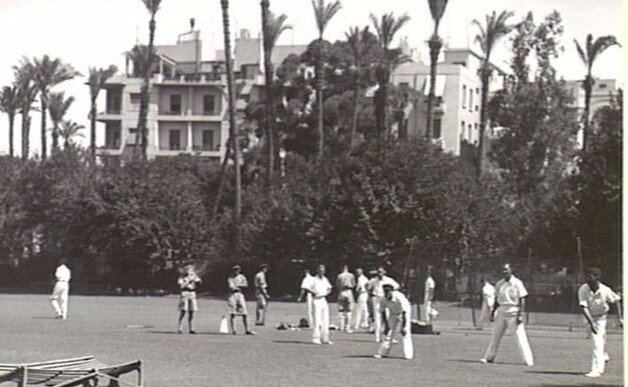A cricketer’s story
Folk who walk from Sydney’s Central Station to the popular sporting venues at Moore Park cross the Albert ‘Tibby’ Cotter Pedestrian Bridge, a shared pedestrian and cycle way over one of Sydney’s widest and busiest arterial roads, Anzac Parade. As they pass, a few ask themselves who Tibby Cotter was. Some stop to read the small plaque It reads:
Albert "Tibby" Cotter (3 December 1883 – 31 October 1917) was an Australian cricketer who played in 21 Tests between 1904 and 1912 (89 wickets, average 28.64), and 115 first-class matches between 1901 and 1914 (including 123 wickets, average 23.45 for New South Wales).
As a tribute to Tibby, the bridge was opened to coincide with the 2015 ICC Cricket World Cup.
But who was Albert ‘Tibby’ Cotter?
Everyone knew in 1909! Tibby was our bowling spearhead!
According to those who knew him, he was a strikingly handsome and beautifully proportioned athlete, was always cheerful and modest and generous in his praise of others. Very fast, but often erratic, his slinging action could make the ball lift high from a good length He was able to bowl for long spells and was a good fieldsman and a handy lower order batsman. His happy nature endeared him to all lovers of the game. It has also been said that he was a bachelor; a larrikin, and a magnet for women.
Some of Tibby’s most notable performances were:
While playing for New South Wales against Queensland on April 4th 1904, he captured 4 wickets for 5 runs.
While playing for Australia against Worcestershire, he took seven wickets for fifteen runs in the first innings, then took all five Worcestershire wickets for nineteen runs in the second innings before rain halted play
In the third test against England at Leeds in July 1909, Tibby took five second innings wickets for just 38 runs.
Playing for Glebe against Sydney in April 1911, Tibby took seven wickets for 39, including two wickets with consecutive balls. Nine balls later, he ripped through four more wickets with consecutive balls.
Cotter bowled fast with an intimidating slinging action. In his first match on the 1905 tour of England, struck that grand old man of English cricket, W.G. Grace fair on the chest with a wild full toss. The outraged British press demanded he temper his bowling, which only served to set the turnstiles ticking.
What did Tibby Cotter do in winter? He played Rugby as a hard-running full-back, centre, and wing three-quarter for Glebe!
Unfortunately, Tibby’s test career was cut short.
In February 1912, a confrontation between cricket administrators and players came to a head. Six of Australia's leading players refused an invitation to tour England for the 1912 Triangular Tournament between England, South Africa and Australia. The root cause of the confrontation was disputed distribution of cricket revenue these tours raised. The issue was only redressed by the establishment of World Series Cricket by Kerry Packer and friends in the 1970s. Cotter was one of the six, probably to the relief of England’s embattled batsmen
When World War I erupted, at age 31, Cotter joined the army. As with other sporting champions, he was used in the AIF recruiting campaign as Australia prepared to enter the conflict.
Despite not being a rider, Cotter joined the Australian Light Horse. Tibby fought at Gallipoli and was commended for his actions under heavy fire during the second battle of Gaza. The official history recorded that: “he behaved in action as a man without fear”. Tibby was subsequently he promoted lance corporal but soon reverted to trooper at his own request.
Of course, it seemed that Tibby’s test career was over but, while serving in Cairo as the troops prepared for the Gallipoli landings, he participated in a unique Australia vs. England ‘Test Match’ played in 1917 between two teams made up from the Australian and British troops stationed in Palestine.
Cricket at El Gezirah, Cairo
Tibby Cotter was killed in action during the famous mounted charge of the 4th Light Horse Brigade at Beersheba, last large-scale horseback charge of history. Although the Light Horsemen were employed as mounted infantry, in the late afternoon of 31 October 1917 the 4th Light Horse Brigade, of which the 12th Regiment was part, captured Beersheba by a brilliant cavalry charge. Cotter was there as a stretcher-bearer. At the end of the charge, as troops dismounted to engage the enemy, a Turk shot Cotter dead at close range. He is interred at the Beersheba War Cemetery, near Beersheba, 120 km south-west of Jerusalem. Tragically, his brother John was killed at Ypres, Belgium on October 1 of the same year.
Tibby’s body is marked with X
Vale Albert ‘Tibby’ Cotter 1883–1917’, cricketer, rugby player , war hero, good bloke.
How does Cotter rank? He took eight or more wickets in a match four times from his 21 Tests, and his strike rate of 52.0 precisely matches that of Dennis Lillee. Enough said!
Conflicting accounts of the El Gezirah ‘test match’ and Tibby’s death shroud these events in mystery. My own take on them appear in my book Solly’s Legacy.. What is clear in all accounts is that Tibby ripped through the English lineup and left their hopes shattered.






